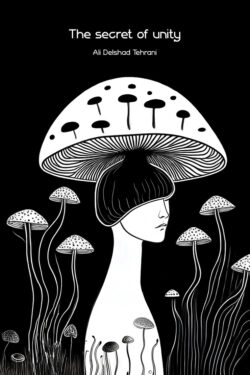Invisible Boundaries Ali Delshad Tehrani
The Rise of Reason in Collective Mind and Power Structures
Millions of years ago, on the African continent, groups of early primates lived in lush and fertile ecosystems. Their primitive social structures were built upon coexistence, care for offspring, and collective foraging. With resources relatively abundant, their environment demanded neither constant violence nor intense competition among members. Yet, as in every stage of evolution, such stability was temporary.
Climatic shifts and declining rainfall gradually transformed dense forests into drier, more open savannas. This was not merely an environmental change—it redrew the borders of populations. The Congo River became a powerful natural divide, separating certain groups and setting the stage for behavioral, social, and even neurophysiological differentiation along two distinct evolutionary paths.
Those who remained within the forests followed a trajectory that would eventually lead to species such as chimpanzees. In this resource-rich yet internally competitive habitat, patterns of organized violence, political alliances among males, and hierarchical social systems emerged. Access to resources—especially to females and social status—depended on physical strength and aggression. The alpha male not only dominated mating opportunities but controlled the entire group, maintaining his position through temporary alliances with other males.
In contrast, those who migrated to the open plains faced scattered resources, more predators, and harsher conditions. Survival demanded cooperation and stable bonds above all. This evolutionary route, which later gave rise to species like baboons, favored social systems where females held central roles, relationships were built upon enduring alliances, and aggression gave way to subtler forms of social negotiation. Power in these societies was not monopolized but distributed through connection.
The divergence between these evolutionary paths extended far beyond social organization. Patterns of mating, parenting, cooperation, and even expressions of aggression evolved in radically different ways. Among chimpanzees, sexual relations are competitive and monopolized—dominant males control females and secure reproductive access. In baboons, mating systems are more open; females enjoy greater freedom of choice, and males rely on care and friendship rather than force to gain acceptance.
These differences do not stem from innate essence but from environmental pressures, population dynamics, and the workings of natural selection. Neurons, hormones, and reward and threat systems were recalibrated in response to distinct ecological demands. What we observe today in chimpanzees and baboons reflects the adaptive logic of the brain under differing conditions—a brain born from a common origin but sculpted into contrasting behavioral architectures by its surroundings.
Yet these behavioral patterns did not remain confined to nonhuman primates. The human mind, with its added layers of self-awareness, language, memory, and narrative, preserved both trajectories in symbolic form. We are heirs to both. We maintain chimpanzee-like hierarchies in our systems of power and command, while also embodying baboon-like solidarity in our networks of care and familial bonds.
What separates us from our primate ancestors is not merely the complexity of our brain or the capacity for language—it is the ability to create meaning. Unlike other animals, humans do not settle for survival or power alone. We interpret the world, build stories around it, and transmit those stories through language, symbols, laws, and rituals. The mind, to preserve its coherence, demands a framework. And these frameworks, though originally constructed to make sense of existence, eventually become the very structures that define and constrain us.
Let us take a shorter step back—not millions of years, not even to the Middle Ages, but only about 140 years before the printing of this book—to the same Congo River. By then it was no longer a mere natural border, but one of the most brutal invisible borders in human history. In the late nineteenth century, the Berlin Conference handed over an immense territory—dozens of times the size of Belgium—to King Leopold II, not as a colony of his nation but as his personal possession. Behind slogans of “civilization” and “free trade” unfolded a machinery of exploitation that consumed millions of lives.
Global demand for rubber led to a system of forced quotas. Local villagers were compelled to harvest latex and, if they failed, faced punishments that remain almost unimaginable: burned villages, hostage-taking, and severed hands. The precise death toll can never be known, but many historians speak of millions perishing within just two decades.
Here we see how an invisible border—a story about “civilization” and “legitimate ownership”—can solidify into a legal and economic institution, and then into a mechanism that pushes the line between “us” and “them” to the brink of death itself. The Congo River, in this sense, became not a geographic divide but a symbol of how meaning transforms into power, and power into destruction.
The structures I call invisible borders are no longer made of land or rivers but of belief and meaning. Our minds construct them to simplify a complex, uncertain world: us and them, black and white, free and enslaved, sacred and profane, true and false. Borders that were once useful for survival have thickened over time into lines for which humans are willing to kill—or die.
This book is an attempt to examine those borders—not to erase or judge them, but to understand how they are built. Its focus is not on external systems, but on the internal architectures that make them possible: neurons, memory, fear, reward, hormones, narrative, and belief.
The examples drawn from nations, ideologies, or religions are not meant to condemn or glorify any particular culture or system. Likewise, references to Scandinavian societies are not to idolize them. The purpose is to explore the collective human mind as it manifests through diverse historical and cultural forms. The subject is not the content of beliefs, but their structures—the frameworks through which the collective mind organizes reality.
In Mental Reality, the first volume, my attention was on the inner architecture of the individual mind. There, I showed that human experience arises from mental pre-contexts—that every perception gains meaning only from the first-person perspective. The mind, as a dynamic field, shapes all its contents, from the simplest sensations to the most abstract thoughts, within those contexts. But the human being is never an isolated individual. From the beginning, life has been embedded in community. No mind forms apart from other minds, and no experience endures outside language, culture, and institutions. If the first volume explored the zero-point of individual experience, this one moves outward—to the shared architecture of minds and the borders they collectively construct.
Invisible borders are the frameworks that organize our collective world. They are not lines on a map or walls of stone, but distinctions drawn in minds and then institutionalized in systems and laws—the border between self and other, right and wrong, truth and falsehood, sacred and profane. These borders generate both cooperation and exclusion, solidarity and domination. Just as mental pre-contexts determine what can or cannot be perceived by an individual, invisible borders determine what can or cannot be accepted within a culture.
This book seeks to rethink those borders—not from within any single tradition, but through a dialogue between neuroscience, psychology, anthropology, and philosophy. Its aim is to build an analytical framework capable of revealing how these borders arise, how they persist through history, and why they must constantly be questioned.
We live surrounded by invisible borders, often unaware of their presence. We speak languages shaped before our birth, obey laws rooted in centuries past, and carry values reproduced across generations. None of these were our personal creations, yet all are etched into our minds and have become part of who we are.
The references to political philosophers in this work do not imply agreement. Sometimes they serve as inspiration, sometimes as critique. What is written here arises from interpretations shaped by my own mental pre-contexts, and thus may differ entirely from the intentions of the original thinkers. Others may read the same words and see something else—just as every mind, individual or collective, perceives the world from its own zero-point. It is even possible that this very book, despite its intentions, may one day become raw material for new invisible borders or ideologies. Such a risk always exists, which is precisely why awareness and continual reexamination are essential.
The question this book poses is how to see this hidden web—how to recognize that “self” and “other” are not natural truths but mental constructions; that “rights,” “freedom,” or “law” are not eternal essences but historical creations of the human brain. The point is not to deny these concepts but to understand their fragility and impermanence. Every border, once drawn, carries within itself the potential for collapse. Only by seeing these borders can we know when to cross them, when to preserve them, and when to recreate them.
We inhabit a world in constant motion, yet the mind fails to perceive it. The Milky Way alone—one among hundreds of billions of galaxies—spins its spiral arms, each holding millions of stars. Our Sun, a peripheral star within one of these arms, carries its planets around the galactic center, while the galaxy itself drifts within an even larger cosmic cluster. All this unfolds amid the grand expansion of the universe.
From this perspective, our position on Earth is nothing more than a faint tremor on a speck of dust within an endless storm. The Earth orbits the Sun, the Sun orbits the galaxy, and the galaxy itself moves through a cosmic current. Our relative speed, from an external vantage point, reaches millions of kilometers per hour—yet we feel none of it. We sit still, see the world as calm, and sometimes imagine ourselves at its center.
We are like a bacterium resting on a mote of dust in a raging whirlwind—unaware of the chaos surrounding it, or of its own fragility and transience. Its life may last mere hours, yet within that fleeting moment it perceives its world as stable, even self-made. So do we: in ignorance of the vastness around us, we call ourselves the noblest of bacteria.
This book is written from that perspective. It is an attempt to show that science and philosophy, narrative and experience, can serve as instruments for casting a faint light into the darkness where borders are formed—and where they dissolve. If Mental Reality explored the individual zero-point, showing that human experience begins from a singular and inaccessible perspective, this volume turns to another angle: where individual experiences intertwine to form collective structures—always fragile, always at risk of breaking apart.
This is not a prescription for fixing the world or a blueprint for utopia. Its purpose is to expose the mechanisms that shape our intersubjective reality. Invisible borders cannot be completely escaped, but they can be recognized and reimagined. This book is an invitation to question them—not to abolish them, but to learn how to live within them.
Invisible Borders moves beyond the individual mind into the collective one, where meaning, morality, and power intertwine, and the boundary between survival and consciousness is constantly shifting. This book seeks to understand the mechanisms through which fear, memory, and the need for coherence give rise to culture, rationality, and ideology—mechanisms that also contain within them the seeds of their own collapse.
Along this path, humanity confronts nihilism, where meaning disintegrates so that a new moral horizon can emerge. From this embrace with nothingness, an endless ladder unfolds—a morality in becoming, never reaching a final point. On the far horizon, Wisdorise appears as the awakening of wisdom within the collective mind, not as a promise of salvation, but as a capacity to live within a world that is diverse, impermanent, and perpetually re-created.





